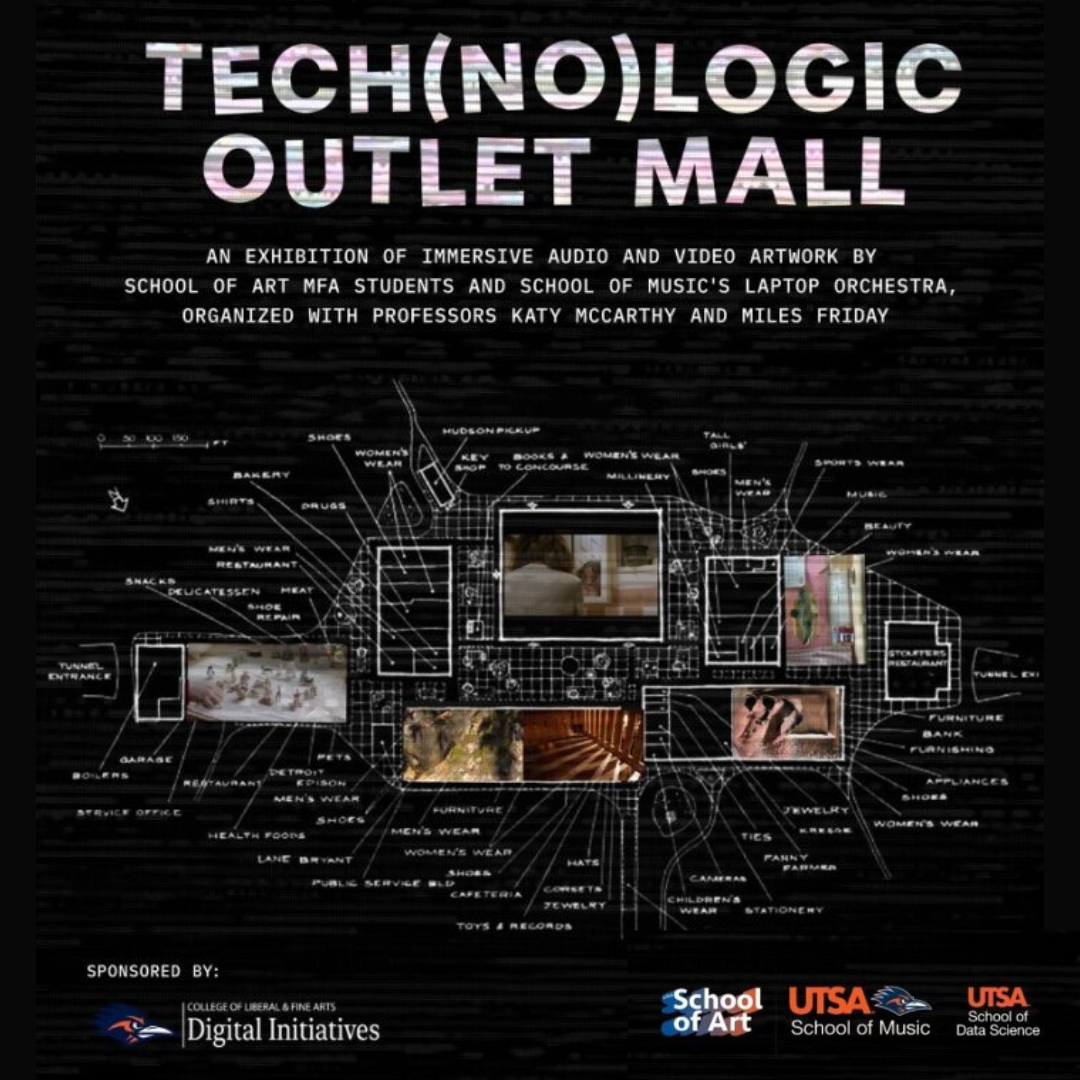Posted on April 30, 2024 by UTSA School of Data Science

The UTSA School of Data Science (SDS) is hosting an exhibition of immersive audio and visual art, created by students in the College of Liberal and Fine Arts (COLFA). On Wednesday, May 1, from 4-6:45pm visitors can experience live, pre-recorded, and interactive installations at San Pedro I as part of the exhibit entitled Tech(no)logic Outlet Mall. The name is a nod to the à la carte manner in which attendees can encounter the exhibition, says Assistant Professor of Digital Music, Miles Jefferson Friday, DMA.
“There will be different stations and stops for you to ‘shop around’ with your ears and eyes and explore what’s going on in the room,” he explained.
Tech(no)logic Outlet Mall features students from Friday’s San Antonio Improvisatory Laptop Orchestra (SAILOR) as well as a Master of Fine Arts seminar course in new media taught by his colleague, Assistant Professor of New Media, Katy McCarthy, MFA. SAILOR is open to students of all majors, but each is required to develop a semester project and encouraged to partner with one of McCarthy’s MFA students in the process. This type of interdisciplinary collaboration has been a goal for both professors since they joined UTSA in 2023.
“We’ve been in conversation since we were hired about ways to work together,” McCarthy said. “It’s really cool to have Miles onboard, and to think about digital music, and for my students to get a taste of what happens in Miles’ classroom and his students to see what happens in my classroom. Those kinds of moments of sharing are really powerful classroom moments.”
The professors feel these moments have positively impacted students in both courses. The students in SAILOR, for example, can explore how sound operates differently in different spaces and with different objects, while the MFA students can further appreciate sound as a means of artistic expression. The professors have also met with their students outside the classroom, touring locations such as the FL!ght Gallery, and even the School of Data Science, all to help the students develop fresh new perspectives.
While the School of Data Science may seem like an odd choice for art and music students to set up shop, Friday notes the strong connections between the disciplines. Indeed, about half the students in SAILOR are computer science majors.
“Recorded audio is recorded data, and then you’re manipulating it and putting it in different forms,” he said. “You can do that through graphic manipulation, but you can also go in and program and code and work with the audio on a numerical basis.”
Although McCarthy’s course is primarily focused on video, this too requires the recording and manipulating of data, including using coding software to apply effects to their work. Additionally, she highlights the versatility of her students' projects beyond video. For example, she mentions E. Acuna, a student who creatively uses radio telescopes to convert radio frequencies into sound, which is then choreographed into dance performances.
But if it’s hard to see the artistry through the computers and the coding, Friday points out that technology has always played a pivotal role in the arts. The electric guitar, the synthesizer, and even the piano were all technological revolutions that forever changed the way music was written and performed just as the camera, editing software, and even artificial intelligence have changed and continue to change what we consider visual art.
“As a composer and a creator, you’re always trying to find new tools that open up new creative avenues for thinking and experimentation,” Friday said. “Also, as a teacher you have an obligation to students to try to share and show them proper tools for creative development and production, which will only be more and more prevalent as time goes on.”
McCarthy agrees, saying some of her students are initially perplexed by new media because they aren’t familiar with what it is and what it can do.
“Few high school programs teach video art or digital media,” she explained. “But that doesn’t mean undergrads shouldn’t be exposed and have the opportunity to make that choice; I think many students do really find their voice with those tools which are pretty conventional now, like a video camera.”
Both professors are grateful to the School of Data Science for offering a space to not only host their students’ work, but also promote a deeper conversation about art, performance, and technology.
“We were looking for performance spaces, and spaces that could be interdisciplinary in how they present art and work with it,” Friday said, “and the School of Data Science seemed like a great place to do that. They were eager and open to art and data-driven art, and things that would take technologies and tech skills, and having these kinds of creative modes of presentation.”
Friday and McCarthy say they are looking forward to continued collaboration in the future. Students interested in joining SAILOR or learning more about digital media, are encouraged to sign up for the courses, regardless of their major or experience level. All that’s required is an open mind and a desire to be creative. For more information on UTSA art and music, be sure to follow both on Instagram at https://www.instagram.com/utsa.school.of.art/ and https://www.instagram.com/utsamusic/.

